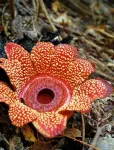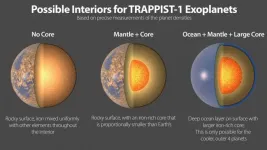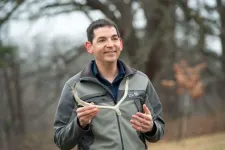(Press-News.org) Researchers at the Consejo Nacional de Investigaciones Científicas y Técnicas (CONICET) in Argentina have found that, since the 1990s, up to 25% of reported bee species are no longer being reported in global records, despite a large increase in the number of records available. While this does not mean that these species are all extinct, it might indicate that these species have become rare enough that no one is observing them in nature. The findings appear January 22 in the journal One Earth.
"With citizen science and the ability to share data, records are going up exponentially, but the number of species reported in these records is going down," says first author Eduardo Zattara (@ezattara), a biologist at the Pollination Ecology Group from the Institute for Research on Biodiversity and the Environment (CONICET-Universidad Nacional del Comahue). "It's not a bee cataclysm yet, but what we can say is that wild bees are not exactly thriving."
While there are many studies about declining bee populations, these are usually focused on a specific area or a specific type of bee. These researchers were interested in identifying more general, global trends in bee diversity.
"Figuring out which species are living where and how each population is doing using complex aggregated datasets can be very messy," says Zattara. "We wanted to ask a simpler question: what species have been recorded, anywhere in the world, in a given period?"
To find their answer, the researchers dove into the Global Biodiversity Information Facility (GBIF), an international network of databases, which contains over three centuries' worth of records from museums, universities, and private citizens, accounting for over 20,000 known bee species from around the world.
In addition to finding that a quarter of total bee species are no longer being recorded, the researchers observed that this decline is not evenly distributed among bee families. Records of halictid bees--the second most common family--have declined by 17% since the 1990s. Those for Melittidae--a much rarer family--have gone down by as much as 41%.
"It's important to remember that 'bee' doesn't just mean honeybees, even though honeybees are the most cultivated species," says Zattara. "Our society's footprint impacts wild bees as well, which provide ecosystem services we depend on."
While this study provides a close look at the global status of bee diversity, it is too general an analysis to make any certain claims about the current status of individual species.
"It's not really about how certain the numbers are here. It's more about the trend," says Zattara. "It's about confirming what's been shown to happen locally is going on globally. And also, about the fact that much better certainty will be achieved as more data are shared with public databases."
However, the researchers warn that this type of certainty may not come until it is too late to reverse the decline. Worse still, it may not be possible at all.
"Something is happening to the bees, and something needs to be done. We cannot wait until we have absolute certainty because we rarely get there in natural sciences," says Zattara. "The next step is prodding policymakers into action while we still have time. The bees cannot wait."
INFORMATION:
This work was funded by CONICET with additional support from Indiana University at Bloomington (USA), the Wissenschaftskolleg zu Berlin (Germany), and the END
Although electric vehicles that reduce greenhouse gas emissions attract many drivers, the lack of confidence in charging services deters others. Building a reliable network of charging stations is difficult in part because it's challenging to aggregate data from independent station operators. But now, researchers reporting January 22 in the journal Patterns have developed an AI that can analyze user reviews of these stations, allowing it to accurately identify places where there are insufficient or out-of-service stations.
"We're spending billions ...
On January 22 in Current Biology, a team of Harvard-led researchers presented the most complete genome yet assembled of one of the major Rafflesiaceae lineages, Sapria himalayana.
The species is found in Southeast Asia and its mottled red and white flower is about the size of a dinner plate. (It's more famous cousin, Rafflesia arnoldii, produces blossoms nearly three feet in diameter, the largest in the world.)
The genetic analysis revealed an astonishing degree of gene loss and surprising amounts of gene theft from its ancient and modern hosts. These findings bring unique perspectives into the number and kind of genes it takes to be an endoparasite (an organism that is completely dependent on its host for all nutrients), along ...
What The Study Did: In this observational study, the spread of SARS-CoV-2 infection during a period of lockdown in southwest Germany was particularly low in children ages 1 to 10 years old. Overall, this large SARS-CoV-2 prevalence study in children is instructive for how ad hoc mass testing provides the basis for rational political decision-making in a pandemic setting.
Authors: Burkhard Tönshoff, M.D., of the University Children's Hospital in Heidelberg, Germany, and Klaus-Michael Debatin, M.D., of Ulm University Medical Center in Ulm, Germany, are the corresponding authors.
To ...
A new international study led by astrophysicist Eric Agol from the University of Washington has measured the densities of the seven planets of the exoplanetary system TRAPPIST-1 with extreme precision, the values obtained indicating very similar compositions for all the planets. This fact makes the system even more remarkable and helps to better understand the nature of these fascinating worlds. This study has just been published in the Planetary Science Journal.
The TRAPPIST-1 system is home to the largest number of planets similar in size to our Earth ever found outside our solar system. Discovered in 2016 by a research team led by Michaël Gillon, astrophysicist at the University of Liège, the system offers an insight into the immense ...
ITHACA, NY - Biologists have long wondered how complex organisms contain a variety of dramatically different types of cells with specialized functions, even though all of those cells are genetically identical.
New research reveals how proteins, called "pioneer transcription factors," help turn on key genes that give cell types their unique properties and functions.
These pioneer factors, it turns out, help unspool tightly wound coils of DNA so that genetic blueprints in genes can be read and proteins that play roles in biological processes can be made.
The study in fruit flies, "Pioneer-like Factor GAF Cooperates with PBAP (SWI/SNF) and NURF (ISWI) to Regulate Transcription," was published Dec. 10 in the journal Genes & Development.
"We know pretty ...
January 22, 2021 - Patients with substance use disorders (SUDs) being treated for serious medical conditions are more likely to leave the hospital against medical advice (AMA) than those without addiction. A special type of contract with healthcare providers might enable patients to consent in advance to life-saving medical care - even if they later refuse treatment, according to a commentary in the Journal of Addiction Medicine, the official journal of the American Society of Addiction Medicine (ASAM). The journal is published in the Lippincott portfolio by Wolters Kluwer.
The Substance Use Advance Directive (SUAD) "has the potential to greatly improve the current state of treatment for life-threatening comorbid conditions in SUD patients through ...
Human activities might have shifted the movement of caribou in and near the Arctic National Wildlife Refuge, according to scientists with the University of Cincinnati.
Each year caribou take on one of nature's longest land migrations, trekking hundreds of miles across Alaska and Canada to find food and give birth in their preferred calving grounds.
A UC study published today in the journal Frontiers in Ecology and Evolution identified a shift in one herd's movements after the 1970s that coincided with changes in herd size and climate, and the construction of new roads and other energy infrastructure.
Researchers used isotope analysis of antlers shed by female caribou to track their historical patterns of movement over the landscape. Female caribou are unique among deer for growing ...
COLUMBUS, Ohio - A new study suggests that a lot of people might be going through life with symptoms that resemble concussion - a finding supporting researchers' argument that athletes recovering from a brain injury should be assessed and treated on a highly individualized basis.
In the national study, between 11% and 27% of healthy college athletes with no history of a recent concussion reported combinations of symptoms that met criteria for post-concussion syndrome (PCS) as defined by an international classification system. Among the nearly 31,000 student-athletes surveyed, three factors stood out as the most likely to predict ...
Alongside Dennis vanEngelsdorp, associate professor at the University of Maryland (UMD) in Entomology named for the fifth year in a row for his work in honey bee and pollinator health, Yiping Qi, associate professor in Plant Science, represented the College of Agriculture & Natural Resources on the Web of Science 2020 list of Highly Cited Researchers for the first time. This list includes influential scientists based on the impact of their academic publications over the course of the year. In addition to this honor, Qi is already making waves in 2021 with a new high-profile publication in Nature Plants introducing SpRY, a newly engineered variant ...
Researchers at the Paul Scherrer Institute PSI have put forward a detailed plan of how faster and better defined quantum bits - qubits - can be created. The central elements are magnetic atoms from the class of so-called rare-earth metals, which would be selectively implanted into the crystal lattice of a material. Each of these atoms represents one qubit. The researchers have demonstrated how these qubits can be activated, entangled, used as memory bits, and read out. They have now published their design concept and supporting calculations in the journal PRX Quantum.
On the way to quantum computers, an initial requirement is to create so-called quantum ...





